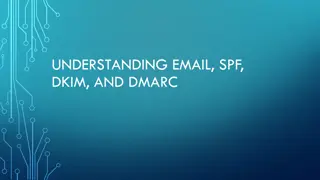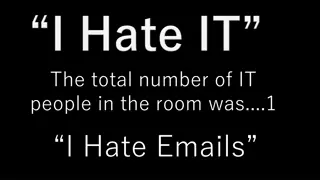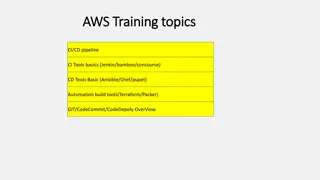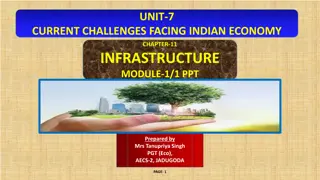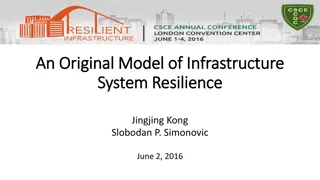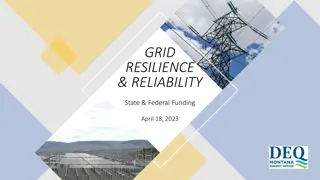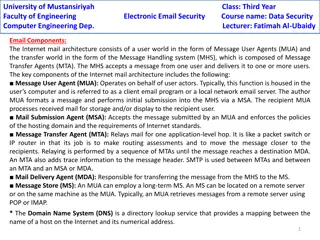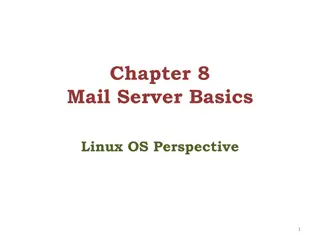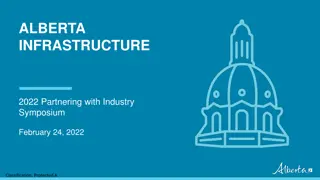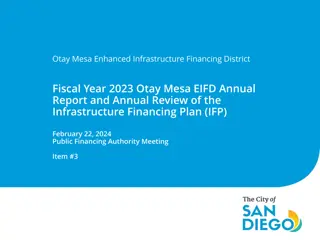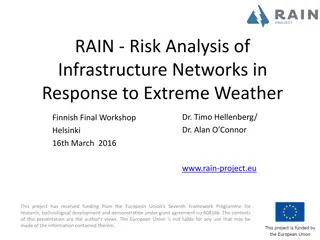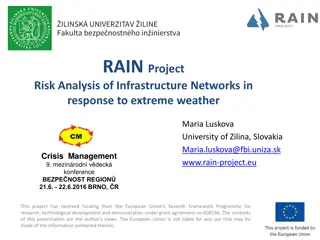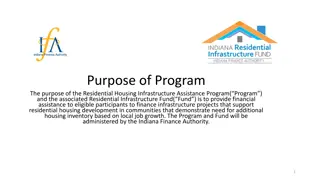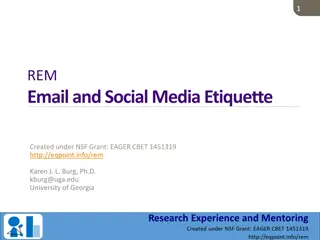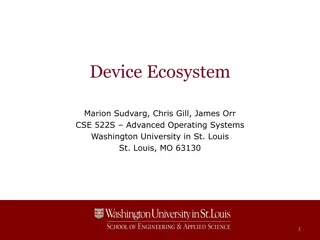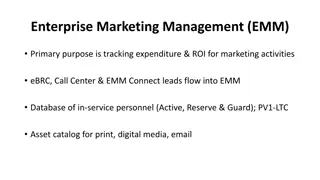Understanding Email Technologies and Infrastructure
Explore the intricacies of email technologies, infrastructure, and architecture, including the format of HTTP messages, the role of proxy servers, creating web servers, and key components of email systems like user agents, mail servers, and SMTP protocol. Delve into email protocols like SMTP, POP3, and IMAP, as well as socket programming and potentially DNS. Follow a scenario involving Alice sending a message to Bob via SMTP, and examine a sample SMTP interaction between mail servers.
Download Presentation

Please find below an Image/Link to download the presentation.
The content on the website is provided AS IS for your information and personal use only. It may not be sold, licensed, or shared on other websites without obtaining consent from the author. Download presentation by click this link. If you encounter any issues during the download, it is possible that the publisher has removed the file from their server.
E N D
Presentation Transcript
Email Session 5 INST 346 Technologies, Infrastructure and Architecture
Muddiest Points Format of the HTTP messages What GET, HEAD, POST actually do Who creates proxy servers? How to create a Web server
Goals for Today Finish Email Review SMTP POP3 and IMAP Learn socket programming Getahead: DNS (maybe!)
Email outgoing message queue user mailbox Three major components: user agents ( mail reader ) mail servers simple mail transfer protocol: SMTP user agent mail server user agent SMTP user agent mail server SMTP User Agent composing, editing, reading email messages e.g., Outlook, Thunderbird, iPhone mail client outgoing, incoming messages stored on server SMTP user agent mail server user agent user agent
Email: mail servers mail servers: mailbox contains incoming messages for user message queue of outgoing (to be sent) mail messages SMTP protocol between mail servers to send email messages client: sending mail server server : receiving mail server user agent mail server user agent SMTP user agent mail server SMTP SMTP user agent mail server user agent user agent
Email: SMTP [RFC 2821] uses TCP to reliably transfer email message from client to server, port 25 direct transfer: sending server to receiving server three phases of transfer handshaking (greeting) transfer messages close command/response interaction (like HTTP) commands: ASCII text response: status code and phrase messages must be in 7-bit ASCII
Scenario: Alice sends message to Bob 4) SMTP client sends Alice s message over the TCP connection 5) Bob s mail server places the message in Bob s mailbox 6) Bob invokes his user agent to read message 1) Alice uses UA to compose message to bob@someschool.edu 2) Alice s UA sends message to her mail server; message placed in message queue 3) client side of SMTP opens TCP connection with Bob s mail server user agent user agent 1 mail server mail server 3 2 6 4 5 Alice s mail server Bob s mail server
Sample SMTP interaction Mail server (client) at crepes.fr has mail to send Client initiates connection to hamburger.edu port 25 S: 220 hamburger.edu C: HELO crepes.fr S: 250 Hello crepes.fr, pleased to meet you C: MAIL FROM: <alice@crepes.fr> S: 250 alice@crepes.fr... Sender ok C: RCPT TO: <bob@hamburger.edu> S: 250 bob@hamburger.edu ... Recipient ok C: DATA S: 354 Enter mail, end with "." on a line by itself C: Do you like ketchup? C: How about pickles? C: . S: 250 Message accepted for delivery C: QUIT S: 221 hamburger.edu closing connection
SMTP: final words comparison with HTTP: HTTP: pull SMTP: push SMTP uses persistent connections SMTP requires message (header & body) to be in 7-bit ASCII SMTP server uses CRLF.CRLF to determine end of message both have ASCII command/response interaction, status codes HTTP: each object encapsulated in its own response message SMTP: multiple objects sent in multipart message
Mail message format SMTP: protocol for exchanging email messages RFC 822: standard for text message format: header lines, e.g., To: From: Subject: different from SMTP MAIL FROM, RCPT TO: commands! Body: the message ASCII characters only header blank line body
Mail access protocols mail access protocol (e.g., POP, IMAP) user agent user agent SMTP SMTP sender s mail server receiver s mail server SMTP: delivery/storage to receiver s mail server mail access protocol: upload to and download from a mail server POP: Post Office Protocol [RFC 1939]: authorization, download IMAP: Internet Mail Access Protocol [RFC 1730]: more features, including manipulation of stored messages in folders on the mail server
POP3 protocol S: +OK POP3 server ready C: user bob ussrid S: +OK C: pass hungry password S: +OKuser successfully logged on authorization phase client commands: user: declare username pass: password server responses +OK -ERR transaction phase, client: list: list message numbers retr: retrieve message by number dele: delete quit C: list S: 1 498 S: 2 912 S: . C: retr 1 S: <message 1 contents> S: . C: dele 1 C: retr 2 S: <message 1 contents> S: . C: dele 2 C: quit S: +OK POP3 server signing off
Comparing POP3 and IMAP more about POP3 previous example uses POP3 download and delete mode Bob cannot re-read e- mail if he changes client POP3 download-and- keep : copies of messages on different clients POP3 is stateless across sessions IMAP keeps all messages in one place: at server allows user to organize messages in folders keeps user state across sessions: names of folders and mappings between message IDs and folder name
Socket programming goal: learn how to build client/server applications that communicate using sockets socket: outbox/inbox between application process and end-end-transport protocol application process application process socket controlled by app developer transport transport controlled by OS network network link link Internet physical physical
Socket programming Two socket types for two transport services: UDP: unreliable datagram TCP: reliable, byte stream-oriented Application Example: 1. client reads a line of characters (data) from its keyboard and sends data to server 2. server receives the data and converts characters to uppercase 3. server sends modified data to client 4. client receives modified data and displays line on its screen
Client/server socket interaction: UDP client server (running on serverIP) create socket: clientSocket = socket(AF_INET,SOCK_DGRAM) create socket, port= x: serverSocket = socket(AF_INET,SOCK_DGRAM) Create datagram with server IP and port=x; send datagram via clientSocket read datagram from serverSocket write reply to serverSocket specifying client address, port number read datagram from clientSocket close clientSocket
Example app: UDP client Python UDPClient include Python s socket library from socket import * serverName = localhost serverPort = 12000 clientSocket = socket(AF_INET, SOCK_DGRAM) message = input( Input lowercase sentence: ) clientSocket.sendto(message.encode(), create UDP socket for server get user keyboard input Attach server name, port to message; send into socket (serverName, serverPort)) modifiedMessage, serverAddress = clientSocket.recvfrom(2048) print(modifiedMessage.decode()) clientSocket.close() read reply characters from socket into string print out received string and close socket
Example app: UDP server Python UDPServer from socket import * serverPort = 12000 serverSocket = socket(AF_INET, SOCK_DGRAM) serverSocket.bind(('', serverPort)) print ( The server is ready to receive ) while True: message, clientAddress = serverSocket.recvfrom(2048) modifiedMessage = message.decode().upper() serverSocket.sendto(modifiedMessage.encode(), clientAddress) create UDP socket bind socket to local port number 12000 loop forever Read from UDP socket into message, getting client s address (client IP and port) send upper case string back to this client
Running Python Install the latest Python 3 from: https://www.python.org/downloads/ Download the programs Materials used in class link from schedule Open two shell windows On a PC, type cmd in the search box On a Mac, open a terminal In one shell, type: python udpserver.py In the other, type: python udpclient.py
Socket programming with TCP client must contact server server process must first be running server must have created socket that welcomes client s contact client contacts server by: Creating TCP socket, specifying IP address, port number of server process when client creates socket: client TCP establishes connection to server TCP when contacted by client, server TCP creates new socket for server process to communicate with that particular client allows server to talk with multiple clients source port numbers used to distinguish clients (more in Chap 3) application viewpoint: TCP provides reliable, in-order byte-stream transfer ( pipe ) between client and server
Client/server socket interaction: TCP client server (running onhostid) create socket, port=x, for incoming request: serverSocket = socket() wait for incoming connection request connectionSocket = serverSocket.accept() create socket, connect to hostid, port=x clientSocket = socket() TCP connection setup send request using clientSocket read request from connectionSocket write reply to connectionSocket read reply from clientSocket close connectionSocket close clientSocket
Example app: TCP client Python TCPClient from socket import * serverName = localhost serverPort = 12000 clientSocket = socket(AF_INET, SOCK_STREAM) clientSocket.connect((serverName,serverPort)) sentence = input( Input lowercase sentence: ) clientSocket.send(sentence.encode()) modifiedSentence = clientSocket.recv(1024) print ( From Server: , modifiedSentence.decode()) clientSocket.close() create TCP socket for server, remote port 12000 No need to attach server name, port
Example app: TCP server Python TCPServer from socket import * serverPort = 12000 serverSocket = socket(AF_INET,SOCK_STREAM) serverSocket.bind(( ,serverPort)) serverSocket.listen(1) print( The server is ready to receive ) while True: connectionSocket, addr = serverSocket.accept() sentence = connectionSocket.recv(1024).decode() capitalizedSentence = sentence.upper() connectionSocket.send(capitalizedSentence. encode()) connectionSocket.close() create TCP welcoming socket server begins listening for incoming TCP requests loop forever server waits on accept() for incoming requests, new socket created on return read bytes from socket (but not address as in UDP) close connection to this client (but not welcoming socket)
DNS: domain name system Domain Name System: distributed database implemented in hierarchy of many name servers application-layer protocol: hosts, name servers communicate to resolve names (address/name translation) note: core Internet function, implemented as application- layer protocol complexity at network s edge people: many identifiers: SSN, name, passport # Internet hosts, routers: IP address (32 bit) - used for addressing datagrams name , e.g., www.yahoo.com - used by humans Q: how to map between IP address and name, and vice versa ?
DNS: services, structure why not centralize DNS? single point of failure traffic volume distant centralized database maintenance DNS services hostname to IP address translation host aliasing canonical, alias names mail server aliasing load distribution replicated Web servers: many IP addresses correspond to one name A: doesn t scale!
DNS: a distributed, hierarchical database Root DNS Servers org DNS servers edu DNS servers com DNS servers poly.edu DNS servers umass.edu DNS servers pbs.org DNS servers yahoo.com DNS servers amazon.com DNS servers client wants IP for www.amazon.com; 1st approximation: client queries root server to find com DNS server client queries .com DNS server to get amazon.com DNS server client queries amazon.com DNS server to get IP address for www.amazon.com
DNS: root name servers contacted by local name server that can not resolve name root name server: contacts authoritative name server if name mapping not known gets mapping returns mapping to local name server c. Cogent, Herndon, VA (5 other sites) d. U Maryland College Park, MD h. ARL Aberdeen, MD j. Verisign, Dulles VA (69 other sites ) k. RIPE London (17 other sites) i. Netnod, Stockholm (37 other sites) m. WIDE Tokyo (5 other sites) e. NASA Mt View, CA f. Internet Software C. Palo Alto, CA (and 48 other sites) 13 logical root name servers worldwide each server replicated many times a. Verisign, Los Angeles CA (5 other sites) b. USC-ISI Marina del Rey, CA l. ICANN Los Angeles, CA (41 other sites) g. US DoD Columbus, OH (5 other sites)
TLD, authoritative servers top-level domain (TLD) servers: responsible for com, org, net, edu, aero, jobs, museums, and all top-level country domains, e.g.: uk, fr, ca, jp Network Solutions maintains servers for .com TLD Educause for .edu TLD authoritative DNS servers: organization s own DNS server(s), providing authoritative hostname to IP mappings for organization s named hosts can be maintained by organization or service provider
Local DNS name server does not strictly belong to hierarchy each ISP (residential ISP, company, university) has one also called default name server when host makes DNS query, query is sent to its local DNS server has local cache of recent name-to-address translation pairs (but may be out of date!) acts as proxy, forwards query into hierarchy
DNS name resolution example root DNS server 2 host at cis.poly.edu wants IP address for gaia.cs.umass.edu 3 TLD DNS server 4 5 local DNS server dns.poly.edu iterated query: contacted server replies with name of server to contact I don t know this name, but ask this server 6 7 1 8 authoritative DNS server dns.cs.umass.edu requesting host cis.poly.edu gaia.cs.umass.edu
DNS name resolution example root DNS server 3 2 recursive query: puts burden of name resolution on contacted name server heavy load at upper levels of hierarchy? 7 6 TLD DNS server local DNS server dns.poly.edu 4 5 1 8 authoritative DNS server dns.cs.umass.edu requesting host cis.poly.edu gaia.cs.umass.edu
DNS: caching, updating records once (any) name server learns mapping, it caches mapping cache entries timeout (disappear) after some time (TTL) TLD servers typically cached in local name servers thus root name servers not often visited cached entries may be out-of-date (best effort name-to-address translation!) if name host changes IP address, may not be known Internet-wide until all TTLs expire update/notify mechanisms proposed IETF standard RFC 2136
DNS records DNS: distributed database storing resource records (RR) RR format:(name, value, type, ttl) type=A nameis hostname valueis IP address type=CNAME name is alias name for some canonical (the real) name www.ibm.comis really servereast.backup2.ibm.com valueis canonical name type=NS name is domain (e.g., foo.com) value is hostname of authoritative name server for this domain type=MX valueis name of mailserver associated withname
DNS protocol, messages query and reply messages, both with same message format 2 bytes 2 bytes message header identification: 16 bit # for query, reply to query uses same # flags: query or reply recursion desired recursion available reply is authoritative identification flags # questions # answer RRs # additional RRs # authority RRs questions (variable # of questions) answers (variable # of RRs) authority (variable # of RRs) additional info (variable # of RRs)
DNS protocol, messages 2 bytes 2 bytes identification flags # questions # answer RRs # additional RRs # authority RRs name, type fields for a query questions (variable # of questions) RRs in response to query records for authoritative servers answers (variable # of RRs) authority (variable # of RRs) additional helpful info that may be used additional info (variable # of RRs)
Inserting records into DNS example: new startup Network Utopia register name networkuptopia.com at DNS registrar (e.g., Network Solutions) provide names, IP addresses of authoritative name server (primary and secondary) registrar inserts two RRs into .com TLD server: (networkutopia.com, dns1.networkutopia.com, NS) (dns1.networkutopia.com, 212.212.212.1, A) create authoritative server type A record for www.networkuptopia.com; type MX record for networkutopia.com
Before You Go On a sheet of paper, answer the following (ungraded) question (no names, please): What was the muddiest point in today s class?



